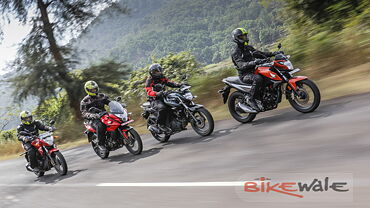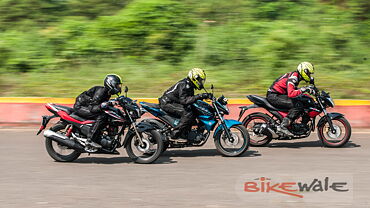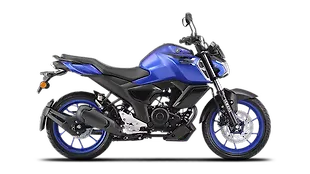Gixxer vs FZ-S V2.0

Although Yamaha is famed for its sporty, fully faired range of motorcycles, its biggest-selling model here in the Indian market is the FZ-S which represents the premium commuter category. The FZ-S is now into its second generation (dubbed V2.0), and its once controversial design bits like the overtly fat rear tyre have matured into a defining character, while the torquey 149cc motor and sporty handling have made it our class favourite.
However, it isn’t the only premium commuter motorcycle in the market. Suzuki’s latest 150cc offering wears the hallowed Gixxer badge and enjoys a nearly similar set of traits as the FZ-S. Suzuki may have taken a while to sit up and take notice, but the new Gixxer is out to prove that it can truly go up against the FZ series.
So can the FZ-S still take victory despite the arrival of the Suzuki? We reveal all.
Design

Most of the buyers looking seriously at either the Gixxer or the FZ-S are those who appreciate aesthetic beauty as much as performance or running costs, if not more. So if it’s street credentials you’re looking for, there is barely any room for disappointment because both Suzuki and Yamaha have nailed it with their respective offerings.
Looks-wise, the Gixxer was unanimously voted as the more appealing motorcycle of the two. It’s streamlined metallic Titan Blue coloured bodywork gleams in sunlight and appears more elegant than this particular FZ-S which is finished in what Yamaha calls Moon Walk white. The Suzuki, in fact, was good enough to become the first topic of discussion everywhere we rode, with highlighting design cues including the well-sculpted fuel tank, compact shrouds and the sharply styled rear panels. The chrome finished dual-exhaust and the stylish six-spoke alloy wheels further add up to the sporty quotient of this motorcycle.
Though it lacks the outright appeal of the much younger Gixxer, the updated FZ-S is a striking looking motorcycle nonetheless. Much like the Suzuki, it has sharp angular body panels highlighted by the attractive looking fuel tank and the tank shrouds on either sides. However, the FZ-S stands apart from the mainstream through its signature body graphics and the aggressively styled tail assembly consisting of a new tail lamp design and clear lens turn indicators housed on an aluminium bracket.
Aesthetically, both these motorcycles share basic styling cues with their beak–like design, forward-biased riding stance, rear set footpegs and the extensive usage of black for the powertrain and side panels. All things considered, it’s the Gixxer that trounces the FZ-S as the most contemporary 150cc naked motorcycle on sale today. Though the FZ-S has evolved the right way when it comes to mid-life makeovers, its updated design is a bit too fussy for my liking. The standard FZ V2.0, instead, would easily be my pick in case I’m obliged to go with a 150cc naked motorcycle by Yamaha.

Engine and Gearbox

In the powertrain department, both these motorcycles left us very impressed albeit in slightly different ways. While the Gixxer’s 155cc air cooled engine has bags full of grunt and is also quite punchy in the way it delivers power, the 149cc single cylinder unit in the FZ-S is incredibly refined and thoroughly modern.
Starting with the Suzuki, this new single cylinder engine has been specifically designed for the Gixxer. Featuring a two valve head, it puts out 14.8bhp of power at 8,000rpm and 14Nm of torque at about 6,000rpm. Yamaha, meanwhile, has also thoroughly worked on the firepower of the updated FZ-S though rather worryingly; the displacement and power figures have gone down a bit compared to the previous model. The engine now develops 12.9bhp and 12.8Nm, 0.88bhp and 0.60Nm less than before.
As a trade-off, the updated FZ-S gets fuel injection as standard and the result is immediate the moment the engine comes to life. Be it at idle or anywhere in the rev band, the FZ-S is smooth and relatively free of unwanted engine vibration. Although it employs a modest single cylinder configuration, the 149cc unit is fairly modern otherwise, featuring a lightweight camshaft, dual-cable enabled throttle body and a closed loop fuel-injection system.
Unlike the FZ-S, the fuel in the Gixxer’s 155cc engine is fed through a carburettor and as a result, the Suzuki falls a tad behind the Yamaha when it comes to absolute refinement and engine smoothness. Past 8,000rpm, the engine gets a bit buzzy which, to be honest, just robs the Gixxer of some of the playfulness exhibited by the overall package.
Out on the open road, both the FZ-S and the Gixxer do not hesitate to rev hard and deliver power in an amazingly linear way. There’s more than enough torque in low and midrange to dart through buzzing city streets and up till 60kmph. At highway speeds, the Gixxer is considerably quicker in terms of roll-on acceleration and the top speed. We especially like the engine’s throaty noise whenever the throttle is wacked open, yet the exhaust note remains restrained enough as to not attract unwanted attention.
Gearbox duties on both these motorcycle are handled by two very different five-speed units. Like the previous model, the gear ratios on the updated FZ-S continue to be on the shorter side. In comparison, the Gixxer’s five-speed unit has evenly spaced ratios that are suitably tall to cover a range of speeds. This explains the significant difference in top speeds wherein the Yamaha feels short of breath at 110kmph, while the Gixxer feels like it could easily go on for another 10kmph or so.
On performance alone, the Gixxer is a truly capable motorcycle, one that is engaging to ride and yet, docile enough to take care of mundane commuting duties. That being said, a handful of extra horses and a higher top speed doesn’t mean much. What’s really more important is how both these motorcycles ride and feel behind the handle bar.
Ride and Handling

The FZ-S and the Gixxer, undoubtedly, are among the most dynamically sorted small capacity motorcycles on sale today. It becomes incredibly difficult, then, to pick the superior handling motorcycle of the two. Judged on engine and gearbox alone, the Gixxer leaves a more positive impression despite the refined nature of the FZ-S. But in terms of ride and handling, there’s no denying the fact that both these motorcycles are almost evenly matched.
Starting with the Gixxer, the motorcycle handles with all the lightness and precision you would expect from a sporty 150cc. The handlebar is wide and very light to operate, but not to the point of any flaw. The FZ-S is equally agile and light on its feet – hardly a surprise when you take in the hardware used by Suzuki and Yamaha. Both these model, in fact, use fat 41mm telescopic forks at the front, large disc brakes, drum rear brakes and tubeless MRF tyres.
As far as handling is concerned, the Gixxer handles remarkably well, whether in a straight line or through the corners. Its compact dimensions matched with the short wheelbase contribute to the quick and easy turn-in even at high speeds. Rather unsurprisingly, the FZ-S is as precise and light when attacking the corners but ultimately it’s the Gixxer which happens to provide a more rewarding experience with its sportier riding stance and better stability over undulating road conditions.
The FZ-S fights back with its rider friendly ergonomics and a slightly more comfortable ride compared to the Gixxer. The wide handlebar coupled with the upright seating position offer great manoeuvring capabilities in city traffic. Further improving rider and pillion accommodation is the spacious saddle and the well positioned foot-pegs. The pillion seat of the Gixxer is not as generous as the FZ-S and neither is it as comfy as the Yamaha in the long run. Though the suspension damping is very well calibrated and that helps in maintaining composure, the ride quality still is not as soft as the FZ-S. All in all, the FZ-S turns out to be more comfortable for both the rider and the pillion, thanks to a more spacious saddle and better ride quality.
Instrument Console and Features

Similarities between the two motorcycles continue as we look into the instrument console. Both the Gixxer and the FZ-S adopt a fully digital cluster. The rectangular binnacle featured on both models has a fairly big display which is surrounded by tell-tale lights for the side indicators, neutral and high beam. A neat touch on the Suzuki is the white shift light that is to be found on the right side of the cluster.
The instrumentation is all digital right from the speedometer and tachometer to the fuel gauge. On the whole, the red back-lit consoles on both these models are very well laid out and are legible under all conditions. Suzuki, rather thoughtfully, has added a gear indicator and a digital clock – features that are bound to be appreciated on a daily basis.
While the FZ-S misses out on a clock and a gear indicator, Yamaha has included an economy indicator, which shows the apt speed one needs to be in for optimum fuel efficiency. The indicator stays on when ridden sanely and goes off when the throttle is pinned hard.
In terms of equipment, the two motorcycles are evenly matched, again. There’s a fully digital instrument console, stylish looking alloy wheels, split grab rails and LED tail lights. Given Suzuki’s considerably lower price tag as against the Yamaha, it comes across as much better value of the two.

Verdict

If you’re looking for a fun, premium 150cc motorcycle, neither of these two models will disappoint. Both offer slick powertrains, sporty handling and affordable running costs. But it’s the newer Gixxer that takes the victory, as it has benefited hugely from a lower price point of Rs 76,400 (ex-showroom). The FZ-S V2.0, on the other hand, is bit of a pricey affair at Rs 82,600 (ex-showroom).
While the FZ-S is noticeably more refined and comfortable, the Gixxer is more rewarding to ride. With its superior front-end grip, more communicative steering and a potent power-plant, the latter feels like a more natural and enjoyable choice from behind the handle bar. Pair those with the Suzuki’s noticeably lower price point and it’s fairly easy to say why we have been seeing more of the Gixxer than the new FZ-S on the streets lately.
Gallery
1/11
Double Tap to Zoom


















































![KTM 390 Adventure X [2025] KTM 390 Adventure X [2025]](https://imgd.aeplcdn.com/272x153/n/cw/ec/190885/390-adventure-x-2025-right-side-view.jpeg?isig=0&q=80)